History
Prior to the Spanish captain's passage through the strait in 1724, Captain Hurle, returning from China in the British East India Company ship Macclesfield, had passed through, in March 1701. [1]
Over time, the strait came to be part of the main shipping route between Singapore and the Sunda Strait (which separates Sumatra from Java, and is an entrance to the Indian Ocean). The waters in and around the strait had many navigational hazards, and the strait itself, although frequently used, was considered to be especially perilous. [2] According to the Great Britain Hydrographic Department’s The China Sea Directory, vol. 1 (1878):
"Many fine ships have been lost in Gaspar strait; not a few on the Alceste reef, from wrongly estimating their distance from the land; but the majority of instances from causes which might have been guarded against by the exercise of due care and judgment." [2]
In 1854, the British Admiralty first issued an Admiralty chart of the strait. It was based on surveys conducted by the United States Navy. The chart was continually updated, most notably following surveys conducted by W. Stanton, a Royal Navy a sailing master, in 1861, and with the assistance of Dutch charts, prepared by the then colonial ruler of the then Dutch East Indies (now Indonesia). [2]

Sumatra is one of the Sunda Islands of western Indonesia. It is the largest island that is fully within Indonesian territory, as well as the sixth-largest island in the world at 473,481 km2 (182,812 mi.2), not including adjacent islands such as the Simeulue, Nias, Mentawai, Enggano, Riau Islands, Bangka Belitung and Krakatoa archipelago.

The South China Sea is a marginal sea of the Western Pacific Ocean. It is bounded in the north by the shores of South China, in the west by the Indochinese Peninsula, in the east by the islands of Taiwan and northwestern Philippines, and in the south by Borneo, eastern Sumatra and the Bangka Belitung Islands, encompassing an area of around 3,500,000 km2 (1,400,000 sq mi). It communicates with the East China Sea via the Taiwan Strait, the Philippine Sea via the Luzon Strait, the Sulu Sea via the straits around Palawan, the Strait of Malacca via the Strait of Singapore, and the Java Sea via the Karimata and Bangka Strait. The Gulf of Thailand and the Gulf of Tonkin are also part of the South China Sea. The shallow waters south of the Riau Islands are also known as the Natuna Sea.

The Karimata Strait is a wide strait that connects the South China Sea to the Java Sea, separating the Indonesian islands of Belitung to the west and Borneo (Kalimantan) to the east. It is the widest strait between the South China Sea and the Java Sea, but its numerous islands and reefs reduce its navigability. Its weather and current is influenced by the annual southeast and northwest monsoon.

Dhow is the generic name of a number of traditional sailing vessels with one or more masts with settee or sometimes lateen sails, used in the Red Sea and Indian Ocean region. Typically sporting long thin hulls, dhows are trading vessels primarily used to carry heavy items, such as fruit, fresh water, or other heavy merchandise, along the coasts of Eastern Arabia, East Africa, Yemen and coastal South Asia. Larger dhows have crews of approximately thirty, smaller ones typically around twelve.

Bangka Belitung Islands is a province of Indonesia. Situated off the southeastern coast of Sumatra, the province comprises two main islands, Bangka and Belitung and numerous smaller ones. Bangka Belitung is bordered by the Bangka Strait to the west, the Natuna Sea to the north, the Java Sea is to the south and the Karimata Strait to the east. The province's capital and largest city is Pangkal Pinang. The province covers an area of 16,424.06 km2 (6,341.37 sq mi) and, as of the 2020 census, the population of Bangka Belitung was 1,455.678.
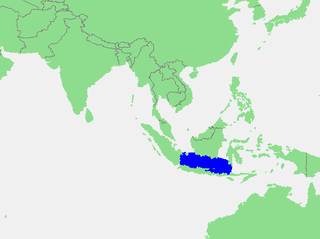
The Java Sea is an extensive shallow sea on the Sunda Shelf, between the Indonesian islands of Borneo to the north, Java to the south, Sumatra to the west, and Sulawesi to the east. Karimata Strait to its northwest links it to the South China Sea. It is a part of the western Pacific Ocean.

Bangka Island is an island lying east of Sumatra. It used to be an administrative part of Sumatra, Indonesia, but has been split off to form the main part of a new Bangka Belitung Province, being one of its namesakes alongside the smaller Belitung Island across the Gaspar Strait. The 9th largest island in Indonesia, it had a population of 1,146,581 at the 2020 Census. It is the location of the provincial capital of Pangkal Pinang, and is administratively divided into four regencies and a city.
Belitung is an island on the east coast of Sumatra, Indonesia in the Java Sea. It covers 4,800.6 km2 (1,853.5 sq mi), and had a population of 309,097 at the 2020 Census. Administratively, it forms two regencies within the province of Bangka-Belitung Islands. The island is known for its pepper and for its tin. It was in the possession of the United Kingdom from 1812 until Britain ceded control of the island to the Netherlands in the Anglo-Dutch Treaty of 1824. Its main town is Tanjung Pandan. The United Nations Educational, Scientific and Cultural Organization has declared 17 tourist attractions in the Belitung Geopark as world geoparks.
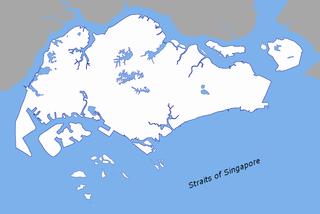
The Singapore Strait is a 114-kilometer-long (71 mi), 16-kilometer-wide (9.9 mi) strait between the Strait of Malacca in the west and the South China Sea in the east. Singapore is on the north of the channel, and the Indonesian Riau Islands are on the south. The two have a maritime border along the strait.
The Tek Sing is one of the few "Asian vessels discovered in Southeast Asia [that we know its name, for] "generally neither name nor date is known. The Tek Sing is an exception." Generally, shipwrecks are named either after a landmark or location near where they were found or the cargo they held. She was a large three-masted Chinese ocean-going junk which sank on February 6, 1822 in an area of the South China Sea known as the Belvidere Shoals. The vessel was 50 meters in length, 10 meters wide and had a burthen of about a thousand tons. Its tallest mast was estimated to be 90 feet (27.43 m) in height. The ship was manned by a crew of 200 and carried approximately 1600 passengers. The great loss of life associated with the sinking has led to the Tek Sing being referred to in modern times as the "Titanic of the East".
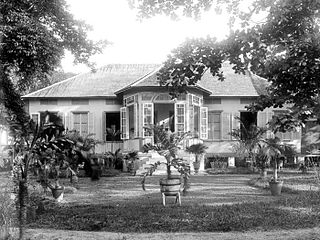
Manggar is a town in the Indonesian province of Bangka-Belitung, Indonesia which is a port on the east coast of Belitung Island, and is the seat of the East Belitung Regency. The town was founded as a tin mining town in the 19th century.

The Jewel of Muscat is a ship based on the design of the Belitung shipwreck, an Arabian dhow that was found off the coast of Belitung Island, Indonesia, in 1998 and subsequently salvaged. It was built in a joint effort by the governments of Oman and Singapore and Mike Flecker, one of the people employed by the salvage company Seabed Explorations at the time of the original recovery.
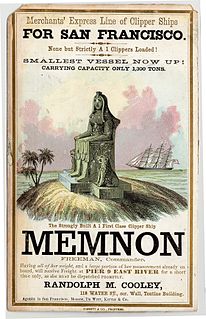
The Memnon was the first clipper ship to arrive in San Francisco after the Gold Rush, and the only clipper to arrive in San Francisco before 1850. Built in 1848, she made record passages to San Francisco and to China, and sailed in the first clipper race around Cape Horn.
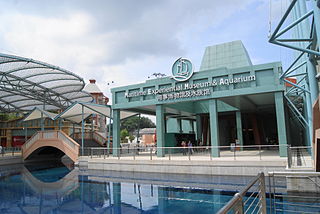
The Maritime Experiential Museum, formerly the Maritime Xperiential Museum and the Maritime Experiential Museum & Aquarium, was a museum in Resorts World Sentosa, Sentosa, Singapore, built to house the Jewel of Muscat. It was opened on 15 October 2011 and was closed on 2 March 2020 to become part of the new Singapore Oceanarium, an expansion of the former S.E.A. Aquarium.

The Belitung shipwreck is the wreck of an Arabian dhow which sank around 830 AD. The ship completed the outward journey from Arabia to China, but sank on the return journey from China, approximately 1.6 kilometres (1 mi) off the coast of Belitung Island, Indonesia. It is unclear why the ship was south of the typical route when it sank. Belitung is to the south-east of the Singapore Strait by 610 kilometres (380 mi), and this secondary route is more normal for ships travelling between China and the Java Sea, which is south of Belitung Island.

The Natuna Sea is an extensive shallow sea located around the Natuna Regency, extended from south of the Riau Islands, east of the Lingga Regency and west of Borneo, to the Bangka Belitung Islands. The islands of the Badas and Tambelan Archipelago are located at its center. Mostly located within Indonesian territorial waters, this sea is the southernmost portion of the South China Sea, and geologically is the part of Sunda Shelf. It communicates with the Java Sea to its southeast via the Karimata and Gaspar Strait east and west of Belitung, and with the Strait of Malacca to the west via the Berhala and Singapore Strait.

Lepar is an island in Indonesia, located off the southeastern coast of Bangka. Administratively part of South Bangka in Bangka Belitung province, it is the third-largest island in the province after its much larger namesakes Bangka and Belitung, with an area of 169 square km. Lepar sits in the Gaspar Strait which separates the two larger islands. It stretches about 22 km east-west and 17 km north-south, with the towns of Tanjunglabu, Tanjungsangkar and Penutuk being the main population centers. It is governed as its own district of Lepar Pongok, which used to include a nearby, medium-sized island of Pongok until 2012 when it separated as its own district of Pongok Islands.
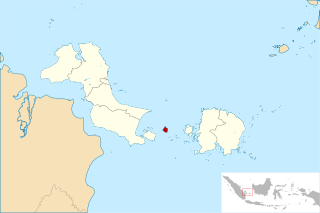
Pongok, sometimes known as Liat, is an Indonesian island which is part of the Pongok Islands District of the South Bangka Regency, Bangka Belitung Province. It comprises over 95% of the district's area and most of its population, with an area of 48.3 square km. It is the 5th largest island in the province, being far smaller than Bangka and Belitung in addition to the islands of Lepar and Mendanau.

Mendanau is an island in the Bangka Belitung province of Indonesia. Located about 6 km off the west coast of Belitung and 20 km from the town of Tanjung Pandan, it is the fourth largest island in the province after Bangka, Belitung and Lepar with an area of approximately 113 square kilometers. Administratively it forms - with about 27 satellite islands - the Selat Nasik District of Belitung Regency, and it is home to 5,674 people at the 2020 Census, mostly spread in 3 settlements.


















